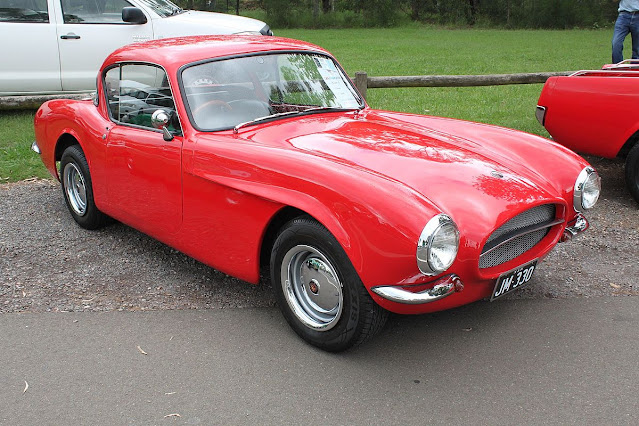The Buckle Sports Coupe was the creation of Bill Buckle, heir to a Sydney Australia car dealership group, when he was 29 years old. The dealership had thrived on the post-war import boom of the new breed of British cars like Armstrong-Siddeley, German brands Borgward and Goliath, and the American DeSoto. After his father's death, the business was run by his father's protégé, retail industry stalwart Bill Lowry.
While traveling to Europe in the late 1940's, his interest in motorsport was keen. He had participated in road races and hill climbs in Australia during his youth, so this was to be expected. Buckle became a regular at grands prix and club events and was invited to drive a Light 15 Citroën in RAC events. In his own words, "While in Europe, I had seen some fiberglass bodied sports cars, (mostly one off) and influenced by some very pretty Ferrari, Maserati, etc. sports cars and the English AC Ace and Austin Healeys', I convinced the board of Buckle Motors that we should build a prototype sports car using locally available components and experimenting with fiberglass."
 |
| The original 1955 Buckle prototype |
Upon his return to Australia, he pitched the idea of building a lightweight sports car to Mr. Lowry, who had grown the family business into a publicly held company. "Fortunately, Bill Lowry was able to convince the board that my dream should become a reality and that the investment was worthwhile," according to Buckle, and so the project went forth.
A workshop was set up at the company's distribution warehouse at Punchbowl, New South Wales. Enlisting the help of childhood friend Charles Buck, work began on the prototype. An Australian Ford Zephyr sedan was to be a donor with its 2.6 liter six-cylinder providing the grunt for the new car. Buckle settled on the Ford because, unlike Holden, they would sell him new parts directly.
 |
| The Production Buckle Sports Coupe of 1957, at rear |
The design came together in a somewhat ad hoc manner at first. "There was no real design drawing of this new car. I just built a chicken wire frame initially to get the shapes, covered it with hessian and then laid a plaster cast over it until I was happy", Buckle recalls. The plaster buck formed the basis for the prototype's molds and 3-5mm thick fiberglass was used in the body. The result was a semi-monocoque with full fiberglass floor, incorporating a fully-hinged hood, grille and front guards. This provided light weight and more than adequate strength.
Buckle also employed Ron Tauranac, an engineer and race mechanic who had made a name for himself building some impressive hill climb cars to design a box-section chassis for the car, featuring a transverse leaf spring at the front complemented by semi-elliptic springs at the rear.
 |
| The 1955 prototype Buckle |
The prototype Buckle convertible, with detachable roof, made its public debut at the 1955 Sydney Motor Show. It was also featured on the front cover of Wheels Magazine in October that same year. The car introduced a number of innovative features including push-button door locks, an adjustable steering column, and a fold-down rear seat for increased trunk space. However its 'gaping mouth' grille was not well received in the press, prompting a re-design during the production car's development.
By 1956, the first production Buckle Coupe was ready with new styling which was very well received. The production article also featured a tuned version of the Ford Zephyr 'six', bored out to 3.0 liters with the addition of a Raymond Mays head. The standard three-speed Zephyr gearbox was enhanced by adding a Laycock de Normanville overdrive which, according to Buckle, gave the sportster "a superb set of ratios."
 |
| The Production Buckle Sports Coupe |
The lightweight fiberglass sportster's performance was surprising, as it turned out, and the Buckle Coupe would prove enormously successful in the hands of its maker and a number of competition drivers, posting every hill climb record in the GT Class plus many lap records including those at Bathurst, Orange, Catalina Park, Sandown and Lowood.
"The win over the Kangaroo Team Aston was particularly satisfying as the car was my daily set of wheels and driven to the circuit, whereas the Astons were trailered" Buckle would recall. Sixteen of the twenty Buckles built competed in motor sport, a highlight being Dick Newell's victory in the 1963 New South Wales GT Championship.
Sadly, this winning career in racing didn't translate to brisk sales over the course of its production run from 1957-59. However, Bill Buckle would go on to to have enormous success with his next project, importing and ultimately manufacturing the Goggomobil line of cars designed by German company Hans Glas Gmbh.
After a long and successful career in the Australian car industry, Bill Buckle retired in Sydney and continues to tinker with cars in his shed. In 2014 he was awarded the Order of Australia Medal, in honor of his lifetime achievements.
Sources:
 |
| The 1955 prototype Buckle |
 |
| The Production Buckle Sports Coupe |
 |
| The Buckle Sports Coupe |
 |
| The Buckle Sports Coupe with its creator |
 |
| The Buckle Sports Coupe, with Bill and Alvia Buckle |
 |
| The Buckle Sports Coupe, head on |
 |
| The Buckle Sports Coupe in yellow |
 |
| The Buckle Sports Coupe head on |
 |
| The Buckle Sports Coupe in green |
 |
| The Buckle Sports Coupe dashboard |
 |
| The Buckle Sports Coupe Ford Zephyr engine |
 |
| The Buckle Sports Coupe interior |






















Comments
Post a Comment